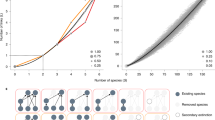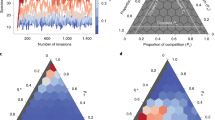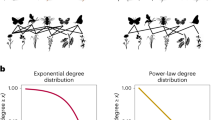Abstract
BIOLOGICAL communities differ in the number of species that they contain; in the number of interactions between species (primarily feeding and competitive relationships); and in the intensity of their interactions. We present here the first extensive empirical data on the relationship between connectance (defined as the fraction of the pairs of species which directly interact1,2) and species richness in biological communities. Our results show that connectance may decline considerably as the number of species increases.
This is a preview of subscription content, access via your institution
Access options
Subscribe to this journal
Receive 51 print issues and online access
$199.00 per year
only $3.90 per issue
Buy this article
- Purchase on Springer Link
- Instant access to full article PDF
Prices may be subject to local taxes which are calculated during checkout
Similar content being viewed by others
References
May, R. M. Nature 238, 413–414 (1972).
May, R. M. Stability and Complexity in Model Ecosystems (Princeton University Press, Princeton, 1973).
Odum, E. P. Fundamentals of Ecology (Saunders, Philadelphia, 1971).
May, R. M. in Theoretical Ecology : Principles and Applications (ed. May, R. M.) 142–162 (Blackwell, Oxford, 1976).
May, R. M. in The Breakdown and Restoration of Ecosystems (ed. Holgate, M. W. & Woodman, M. J.) 11–25 (Plenum, New York, 1978).
Gilpin, M. E. Nature 254, 137–139 (1975).
Goodman, D. Q. Rev. Biol. 50, 237–266 (1975).
Pielou, E. C. Ecological Diversity (Wiley, New York, 1975).
Turk, J., Wittes, J. L., Wittes, R. & Turk, A. Ecosystems, Energy, Population (Saunders, Philadelphia, 1975).
Whittaker, R. H. Communities and Ecosystems 2nd edn (Macmillan, New York, 1975).
Goh, B. S. & Jenkins, L. S. Ecol. Model. 3, 63–71 (1977).
Logofet, D. O. & Svirežev Ju, M. Problemy Kibernetiki 32, 187–202 (1977).
McLean, J. M., Shepherd, P. & Curnow, R. C. in New Trends in Mathematical Modelling (ed. Straszak, A. & Owsiński J. W.) 257–296 (Ossolineum, Wroclaw, 1978).
Barnett, S. & Storey, C. Matrix Methods in Stability Theory (Nelson, London, 1970).
Lawlor, L. R. Am. Nat. 112, 445–447 (1978).
Starý, P. Biology of Aphid Parasites (Hymenoptera: Aphidiidae) with Respect to Integrated Control (Junk, The Hague, 1970).
Starý, P. Acta Ent. Bohemoslov, 75, 164–177 (1978).
Way, M. J. & Cammel, M. E. in Animal Populations in Relation to Their Food Resources (ed. Watson, A.) 229–247 (Blackwell, Oxford, 1970).
McNaughton, S. J. Nature 274, 251–253 (1978).
Starý, P. Acta Ent. Bohemoslov. 74, 1–9 (1977).
Hodek, I. Biology of Coccinelidae (Junk, The Hague, 1973).
Author information
Authors and Affiliations
Rights and permissions
About this article
Cite this article
REJMÁNEK, M., STARÝ, P. Connectance in real biotic communities and critical values for stability of model ecosystems. Nature 280, 311–313 (1979). https://doi.org/10.1038/280311a0
Received:
Accepted:
Issue Date:
DOI: https://doi.org/10.1038/280311a0
This article is cited by
-
Endemic species dominate reef fish interaction networks on two isolated oceanic islands
Coral Reefs (2021)
-
Evolutionary constraints on the complexity of genetic regulatory networks allow predictions of the total number of genetic interactions
Scientific Reports (2019)
-
The joint influence of competition and mutualism on the biodiversity of mutualistic ecosystems
Scientific Reports (2018)
-
Multi‐faceted approaches toward unravelling complex ecological networks
Population Ecology (2015)
-
Structural phase diagrams of animal communities in assessment of freshwater ecosystem conditions
Hydrobiologia (1996)
Comments
By submitting a comment you agree to abide by our Terms and Community Guidelines. If you find something abusive or that does not comply with our terms or guidelines please flag it as inappropriate.



